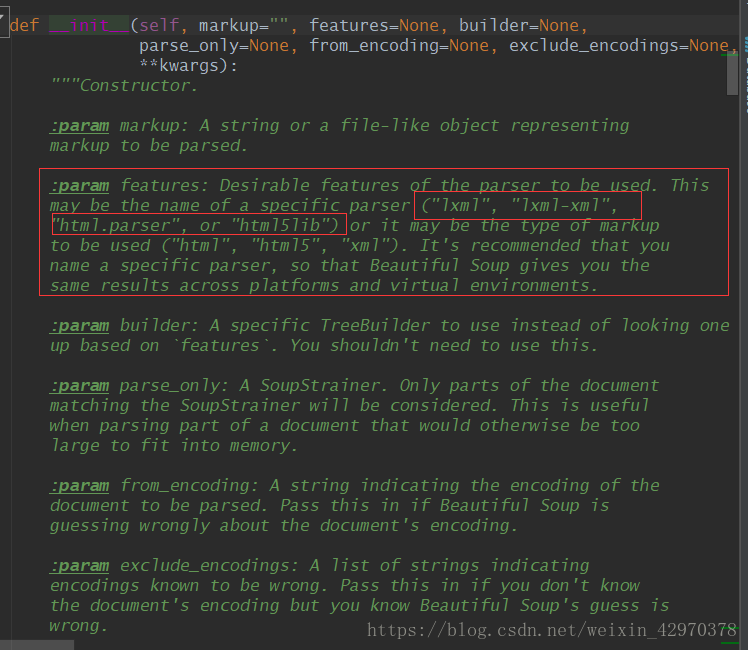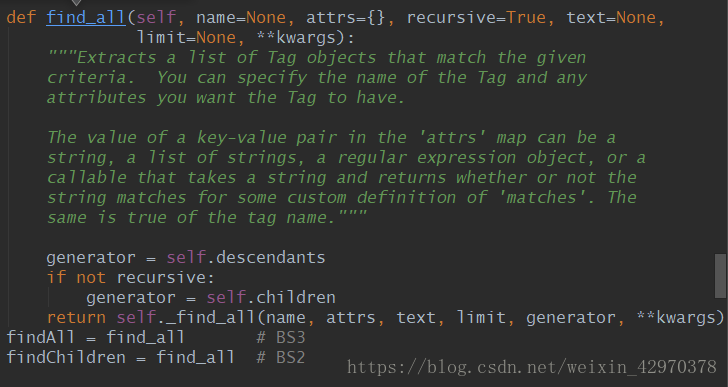爬虫利器BeautifulSoup中find和find_all的使用方法
二话不说,先上段HTML例子
<html>
<head>
<title>
index
</title>
</head>
<body>
<div>
<ul>
<li id="flask"class="item-0"><a href="link1.html" rel="external nofollow" rel="external nofollow" rel="external nofollow" rel="external nofollow" rel="external nofollow" >first item</a></li>
<li class="item-1"><a href="link2.html" rel="external nofollow" rel="external nofollow" rel="external nofollow" rel="external nofollow" rel="external nofollow" rel="external nofollow" >second item</a></li>
<li class="item-inactie"><a href="link3.html" rel="external nofollow" rel="external nofollow" rel="external nofollow" >third item</a></li>
<li class="item-1"><a href="link4.html" rel="external nofollow" rel="external nofollow" rel="external nofollow" rel="external nofollow" >fourth item</a></li>
<li class="item-0"><a href="link5.html" rel="external nofollow" rel="external nofollow" rel="external nofollow" >fifth item</a>
</ul>
</div>
<li> hello world </li>
</body>
</html>
使用BeautifulSoup前需要先构建BeautifulSoup实例
# 构建beautifulsoup实例 soup = BeautifulSoup(html,'lxml') # 第一个参数是要匹配的内容 # 第二个参数是beautifulsoup要采用的模块,即规则
需要注意的是,导入对的模块需要事先安装,此处导入的LXML事先已经安装。可以导入的模块可通过查询BeautifulSoup的文档查看

接下来是find和find_all的介绍
1. find
只返回第一个匹配到的对象
语法:
find(name, attrs, recursive, text, **wargs) # recursive 递归的,循环的

参数:
| 参数名 | 作用 |
|---|---|
| name | 查找标签 |
| text | 查找文本 |
| attrs | 基于attrs参数 |
例子:
# find查找一次
li = soup.find('li')
print('find_li:',li)
print('li.text(返回标签的内容):',li.text)
print('li.attrs(返回标签的属性):',li.attrs)
print('li.string(返回标签内容为字符串):',li.string)
运行结果:
find_li: <li class="item-0" id="flask"><a href="link1.html" rel="external nofollow" rel="external nofollow" rel="external nofollow" rel="external nofollow" rel="external nofollow" >first item</a></li>
li.text(返回标签的内容): first item
li.attrs(返回标签的属性): {'id': 'flask', 'class': ['item-0']}
li.string(返回标签内容为字符串): first item
find也可以通过‘属性=值'的方法进行匹配
li = soup.find(id = 'flask') print(li,'\n')
<li class="item-0" id="flask"><a href="link1.html" rel="external nofollow" rel="external nofollow" rel="external nofollow" rel="external nofollow" rel="external nofollow" >first item</a></li>
需要注意的是,因为class是python的保留关键字,若要匹配标签内class的属性,需要特殊的方法,有以下两种:
- 在attrs属性用字典的方式进行参数传递
- BeautifulSoup自带的特别关键字class_
# 第一种:在attrs属性用字典进行传递参数
find_class = soup.find(attrs={'class':'item-1'})
print('findclass:',find_class,'\n')
# 第二种:BeautifulSoup中的特别关键字参数class_
beautifulsoup_class_ = soup.find(class_ = 'item-1')
print('BeautifulSoup_class_:',beautifulsoup_class_,'\n')
运行结果
findclass: <li class="item-1"><a href="link2.html" rel="external nofollow" rel="external nofollow" rel="external nofollow" rel="external nofollow" rel="external nofollow" rel="external nofollow" >second item</a></li>
BeautifulSoup_class_: <li class="item-1"><a href="link2.html" rel="external nofollow" rel="external nofollow" rel="external nofollow" rel="external nofollow" rel="external nofollow" rel="external nofollow" >second item</a></li>
2. find_all
返回所有匹配到的结果,区别于find(find只返回查找到的第一个结果)
语法:
find_all(name, attrs, recursive, text, limit, **kwargs)

| 参数名 | 作用 |
|---|---|
| name | 查找标签 |
| text | 查找文本 |
| attrs | 基于attrs参数 |
与find一样的语法
上代码
# find_all 查找所有
li_all = soup.find_all('li')
for li_all in li_all:
print('---')
print('匹配到的li:',li_all)
print('li的内容:',li_all.text)
print('li的属性:',li_all.attrs)
运行结果:
---
匹配到的li: <li class="item-0" id="flask"><a href="link1.html" rel="external nofollow" rel="external nofollow" rel="external nofollow" rel="external nofollow" rel="external nofollow" >first item</a></li>
li的内容: first item
li的属性: {'id': 'flask', 'class': ['item-0']}
---
匹配到的li: <li class="item-1"><a href="link2.html" rel="external nofollow" rel="external nofollow" rel="external nofollow" rel="external nofollow" rel="external nofollow" rel="external nofollow" >second item</a></li>
li的内容: second item
li的属性: {'class': ['item-1']}
---
匹配到的li: <li cvlass="item-inactie"><a href="link3.html" rel="external nofollow" rel="external nofollow" rel="external nofollow" >third item</a></li>
li的内容: third item
li的属性: {'cvlass': 'item-inactie'}
---
匹配到的li: <li class="item-1"><a href="link4.html" rel="external nofollow" rel="external nofollow" rel="external nofollow" rel="external nofollow" >fourth item</a></li>
li的内容: fourth item
li的属性: {'class': ['item-1']}
---
匹配到的li: <li class="item-0"><a href="link5.html" rel="external nofollow" rel="external nofollow" rel="external nofollow" >fifth item</a>
</li>
li的内容: fifth item
附上比较灵活的find_all查询方法:
# 最灵活的使用方式
li_quick = soup.find_all(attrs={'class':'item-1'})
for li_quick in li_quick:
print('最灵活的查找方法:',li_quick)
运行结果:
- 最灵活的查找方法: <li class="item-1"><a href="link2.html" rel="external nofollow" rel="external nofollow" rel="external nofollow" rel="external nofollow" rel="external nofollow" rel="external nofollow" >second item</a></li>
- 最灵活的查找方法: <li class="item-1"><a href="link4.html" rel="external nofollow" rel="external nofollow" rel="external nofollow" rel="external nofollow" >fourth item</a></li>
完整代码:
# coding=utf8
# @Author= CaiJunxuan
# @QQ=469590490
# @Wechat:15916454524
# beautifulsoup
# 导入beautifulsoup模块
from bs4 import BeautifulSoup
# HTML例子
html = '''
<html>
<head>
<title>
index
</title>
</head>
<body>
<div>
<ul>
<li id="flask"class="item-0"><a href="link1.html" rel="external nofollow" rel="external nofollow" rel="external nofollow" rel="external nofollow" rel="external nofollow" >first item</a></li>
<li class="item-1"><a href="link2.html" rel="external nofollow" rel="external nofollow" rel="external nofollow" rel="external nofollow" rel="external nofollow" rel="external nofollow" >second item</a></li>
<li cvlass="item-inactie"><a href="link3.html" rel="external nofollow" rel="external nofollow" rel="external nofollow" >third item</a></li>
<li class="item-1"><a href="link4.html" rel="external nofollow" rel="external nofollow" rel="external nofollow" rel="external nofollow" >fourth item</a></li>
<li class="item-0"><a href="link5.html" rel="external nofollow" rel="external nofollow" rel="external nofollow" >fifth item</a>
</ul>
</div>
<li> hello world </li>
</body>
</html>
'''
# 构建beautifulsoup实例
soup = BeautifulSoup(html,'lxml')
# 第一个参数是要匹配的内容
# 第二个参数是beautifulsoup要采用的模块,即规则
# html.parser是python内置的结构匹配方法,但是效率不如lxml所以不常用
# lxml 采用lxml模块
# html5lib,该模块可以将内容转换成html5对象
# 若想要以上功能,就需要具备对应的模块,比如使用lxml就要安装lxml
# 在bs4当中有很多种匹配方法,但常用有两种:
# find查找一次
li = soup.find('li')
print('find_li:',li)
print('li.text(返回标签的内容):',li.text)
print('li.attrs(返回标签的属性):',li.attrs)
print('li.string(返回标签内容为字符串):',li.string)
print(50*'*','\n')
# find可以通过'属性 = 值'的方法进行select
li = soup.find(id = 'flask')
print(li,'\n')
# 因为class是python的保留关键字,所以无法直接查找class这个关键字
# 有两种方法可以进行class属性查询
# 第一种:在attrs属性用字典进行传递参数
find_class = soup.find(attrs={'class':'item-1'})
print('findclass:',find_class,'\n')
# 第二种:BeautifulSoup中的特别关键字参数class_
beautifulsoup_class_ = soup.find(class_ = 'item-1')
print('BeautifulSoup_class_:',beautifulsoup_class_,'\n')
# find_all 查找所有
li_all = soup.find_all('li')
for li_all in li_all:
print('---')
print('匹配到的li:',li_all)
print('li的内容:',li_all.text)
print('li的属性:',li_all.attrs)
# 最灵活的使用方式
li_quick = soup.find_all(attrs={'class':'item-1'})
for li_quick in li_quick:
print('最灵活的查找方法:',li_quick)
到此这篇关于BeautifulSoup中find和find_all的使用详解的文章就介绍到这了,更多相关BeautifulSoup find和find_all内容请搜索自学编程网以前的文章或继续浏览下面的相关文章希望大家以后多多支持自学编程网!

- 本文固定链接: https://zxbcw.cn/post/201558/
- 转载请注明:必须在正文中标注并保留原文链接
- QQ群: PHP高手阵营官方总群(344148542)
- QQ群: Yii2.0开发(304864863)
